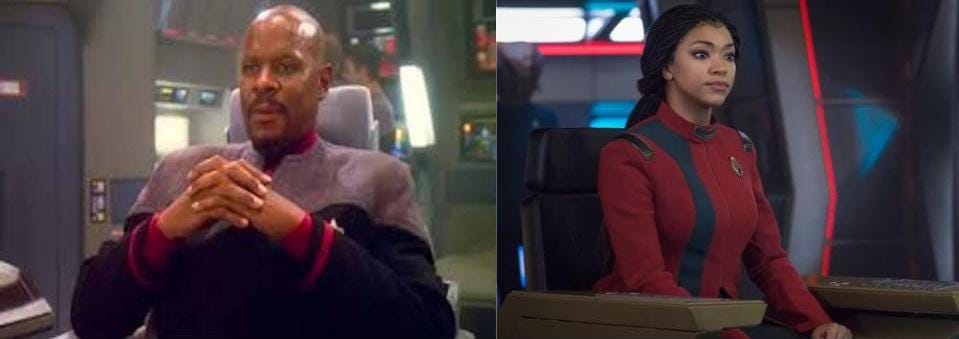What Star Trek’s Treatment of Its Black Captains Tells Us About DEI
Why do Black characters have to work so hard for the same accomplishments on screen, too?
Growing up the way I did between the eastern edge of Mount Vernon and the outskirts of Pelham and the Bronx in the 1970s and 1980s, I always needed ways to sense and see a future for me. The one rerun that was constantly on WNEW-Channel 5 and at least allowed my mind some space to contemplate any future at all was Star Trek: The Original Series (1966-68, canceled in 1969). But I didn’t start out watching the original series deliberately. It really started with Star Trek: The Animated Series, which ran in 1973-74. By its second year, I was old enough to remember its twists, turns, and the general optimism about the future that came through in the voice acting and in the writing. So much so that when I dared to pick up the pieces of what remained of my childhood in 1982, whenever I could, I watched the original series. That included the marathon WNEW ran in the weeks before my maiden voyage to Pittsburgh and the University of Pittsburgh, in the weeks before Star Trek: The Next Generation debuted in 1987.
By then, the show for me was much more than about exploring “strange new worlds” or “seeking out new life and new civilizations.” I did find warp drive, tricorders, phasers, or the constant reminder of Canadian William Shatner’s very bacon-y and numerous on-camera ticks as Captain James T. Kirk, well, fascinating. But really, I spent more time by the end of high school thinking on two issues. One was food replication. How hard would it be to build a quantum computer with the DNA profiles of animals, vegetables, fruit, fungi, legumes, and minerals, combined with recipes, raw organic materials (human waste), and matter-energy conversion to make clean, edible food? Forget about starships or meeting other sentient beings — that would solve humanity’s hunger crisis for all times!
The second issue was about who populated Star Trek. I began thinking about this after watching Star Trek II: The Wrath of Khan (1982) for the first time in 1984 (I didn’t see a first-run movie in a movie theater for six-and-a-half-years, as broke as my family was). I thought about it even more in Star Trek IV: The Voyage Home (1986) — I caught it on cable my senior year of high school (at least we could afford that by 1987). Both movies harped on the theme of humanity once at the brink of self-destruction but just managing to fall short of falling into an abyss, hinting at a World War III and global catastrophes barely beaten back. Between Khan and his merry band of superior human eugenics warriors and the near extinction of the humpback whale (which almost cost the Star Trek Earth of the late-23rd century their lives), it seemed that humans 300 years later had learned some hard lessons about living together.
Yet it only seemed that way, at least to me. When I saw Star Trek: TNG debut in 1987, I was disappointed. The new characters were desperately attempting to fit themselves into the same mold as the classic characters of the original series. The only Black people on the show as regulars were a blind human in Engineering in Geordi La Forge (LeVar Burton) and a somewhat defanged Klingon (Michael Dorn). Otherwise the series was amazingly white.
One of my friends during my first years at Pitt was an even bigger Star Trek fan than me, really, the first Black person I knew as a Trekkie (I didn’t even know what a Trekkie was until I met him). He kept watching and would occasionally pull me into the TV room in our dorm building or his room in our broken-up row house in South Oakland to watch. It did get better by the time I saw the Borg for the first time, before the end-of-Season 3 epic encounter with the Borg that elevated TNG into a much-better series.
The late Gene Roddenberry and his showrunners eventually expanded the Star Trek universe, and created two of the greatest sci-fi shows ever: Deep Space Nine (1993-99) and Discovery (2017-24), with a third, uneven one in Voyager (1994-2001) in between. Trekkies and TV critics both credit these series for their diversity and their choice of lead actors as eventual captains or captains, with Avery Brooks as Benjamin Sisko, Sonequa Martin-Green as Michael Burnham, and Kate Mulgrew as Kathryn Janeway.
Still, the lack of intra-species diversity among Homo sapiens in the Star Trek franchise has stayed with me. Some would say that the Star Trek franchise is DEI at its best. Maybe so. But when one dives deeper into the character arcs of their “diversity hires,” as the “anti-woke” crowd (many of whom see themselves as Trekkies, by the way), it becomes clear how superficially the showrunners tolerated diversity. With DS9 and Discovery, both Sisko and Burnham start off as commanders, not captains. Both characters had to perform extraordinary feats to become captains, after recovering from the most devastating of moments in their lives.
Sisko found himself running a Starfleet starship yard for three years after losing his wife during the disastrous battle with the Borg at Wolf-359. He then got the command of a former Cardassian space station near Bajor. For a person of Sisko’s credentials, this was a really shit assignment in seeing through the transition of power from the catastrophic, 50-year iron-rule of the Cardassians over the Bajorans before their freedom fighting and the Federation forced their withdrawal. That is, until Sisko discovered the first sustainable wormhole in the history of the Milky Way, where Bajoran gods known as The Prophets dwell.
The Prophets proclaimed Sisko as their emissary in the show’s second episode. Still, even with his battles to secure a lasting freedom for Bajorans and negotiating trade and peace with beings on both sides of the wormhole, it would take Sisko three years to earn his fourth pip on his collar. Even then, he would have to work hard to build a life for his son, for himself, for the safety of Bajor and the Federation, and in fulfillment of a prophecy. Only to never fully enjoy the fruits of his labor. The showrunners thought that Sisko becoming “a god” was a fitting end for the character. I’m pretty sure that Brooks as Sisko would disagree, given that he left behind a potentially peaceful retirement on Bajor with his second wife Kassidy Yates and their unborn child, and his son Jake, still in his early 20s.
Burnham’s gauntlet to the captain’s chair was even more daunting, even as it was even more outrageous. The Vulcan-raised human had already overcome the loss of her parents to a Klingon attack and the humiliation of being “only human” around the ever-too-logical Vulcans. The Vulcans denied her a place in the Vulcan Expeditionary Force (the equivalent of Starfleet in the 23rd century) after becoming the first human to attend and graduate from the Vulcan Science Academy. To rise to a senior commander position on the Shenzhou with a trusted mentor in Captain Phillippa Georgiou (Michelle Yeoh), only to piss it away in a moment of mutinous indulgence, helping to start a war she was attempting to avoid. Starfleet then court-marshalled, stripped of rank, and imprisoned Burnham.
Then a mirror universe-version of Captain Gabriel Lorca (Jason Isaacs) provided the humiliated Burnham the opportunity to regain all she has lost on the new starship Discovery. Like Sisko, over the course of three years, battles with the Mirror Universe, with Starfleet, with the Klingons, with a sentient species-ending supercomputer, and with the future itself, the Starfleet that will exist in the late-32nd century finally awarded Burnham the captain’s rank. The series ended after five years, with Admiral Burnham approaching her golden years in the 33rd century, a son who himself had become the captain of a starship she parented with her Kwejian husband Cleveland Booker IV (David Ajala).
Sending Burnham 930 years into the future so that she could have a storybook ending was a nice touch. But that in no way can make up for the fact that Burnham, along with Sisko after and (by the divergence of timelines) before her had to struggle to prove themselves orders of magnitude better than their white counterparts to end up with the same rank of Captain. Although Mulgrew’s character Janeway and her crew spent years on the opposite side of the Milky Way, far away from the main concerns of Starfleet and the Federation, she was already a captain at the start of her series, one who as a white woman did not face the same challenges to her ascendancy at every step.
The reality of my lifetime and the lives of millions of Black and Brown folk in the West is that most of us run a gauntlet of systemic racism, misogynoir, and material inequalities just to get to a very unequal playing field full of landmines. I know this down to my bone marrow. For nearly every job, I have been either well-qualified or overqualified, and just as often underpaid. My accomplishments have either been ignored or claimed by others. Precarity with achievements and credentials in my favor and never-ending whitesplaining and whitemansplaining judgements from the mediocre set could describe every job I’ve had with white folk in charge since 1984.
Although the American public thinks tolerance is the key to harmony, tolerance is like eating rotten fruit on the ground, easily accessible and hardly worth the stomach cramps. It’s often like “tolerating aches and pains” from a hard life — that’s not peace or harmony at all. DEI is fundamentally about curating a culture or an institution that fully embraces marginalized people and their cultures.
If the Star Trek stories of Sisko and Burnham don’t run parallel with the need to be three times as good as white folks who see us as “just very slightly above average” (as one reader described me in 2014), then I have a warp-capable starship in orbit. Star Trek is supposed to represent a best possible future for humankind. But if that future is still tinged with the quiet racism of Black folk having to struggle and suffer trauma along the way to gain a position white characters just get by existing, is that a future anyone should want? No, the future should not be like our present, caught between white monolithic mediocrity and tortured Black excellence.






